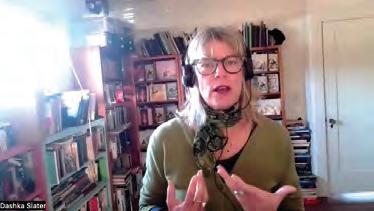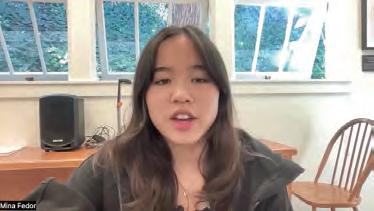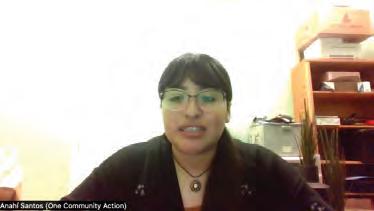
5 minute read
School bullying seen as worsening divisiveness and racism especially at this age of social media
By Jun Nucum
SAN FRANCISCO - Even at a very young age in elementary school, kids are somehow inevitably get involved in bullying, either as the bully, or worse, as the victims who are often hesitant to seek help in healing by talking about their sad if not traumatic experiences shoes impact can last for years and even decades.
Lucky are the ones who have been spared of this so-called ‘coming of age’ stage in a youngster’s life for they are the very rare ones.
In this time of social media anyone can just post anything nasty and hurtful thereby encouraging anonymous cyber bullying to further worsen racial and ethnic relations that are on edge and ever-more polarizing, an Ethnic Media Services briefing examined what’s happening with bullying in schools today, who the prime targets and perpetrators are, and what insights bullying can provide about racial and ethnic tensions among youth.
Those who participated in discussing about this often-sensitive subject included Deputy Director of Strategic Initiatives and External Affairs, California Civil Rights Department Becky Monroe, New York Times Journalist Dashka Slater, author of Youth Wellness Coordinator, One Community Action Anahí Santos, and Founder and Executive Director of AAPI Youth Rising Mina Fedor.
Monroe strongly believes that civil rights issues are at the heart of bullying issues and some are even acts of hate crimes although not all forms of bullying represent unlawful discrimination.
“These acts of hate inflict physical and emotional harm on students and their school communities and schools have a legal obligation to ensure that students are not denied opportunities, treated differently, discriminated against, or harassed because of their race,” Moore stressed. “Conversely, when there is tension and an increase in acts of hate in the greater community, it will be reflected in schools and among students.”
Slater in her book “Accountable: The True Story of a Racist Social Media Account and the Teenagers Whose Lives It Changed” wrote about how one Albany High School student’s racist Instagram account sent the whole community into a six-year saga of interpersonal hate acts and legal tensions.

“The Instagram account featured “images of lynchings and slurs, antisemitism and body shaming, and it was specifically racist towards Black girls at the school, who were friends with the creator of the account, a Korean American junior,” shared Slater. “It was a massive rupture in the community that included a demonstration at school which devolved into violence, and subsequent lawsuits over free speech.”
“We often see kids of color harassed for their identity, who harass someone else for their identity,” she explained. “Many kids are playing both roles, both the bully and the bullied. The radicalization happens online, as social media algorithms serve kids, many who consider themselves anti-racist, extremist content. There is an insane disconnect between what they were doing and who they thought of themselves as being.”
But Slater advised against punishing kids out of bullying as a response to this extremism, schools often rush to disciplinary codes, but Slater said they can’t punish kids out of bullying.

“The same people who have been marginalized by the justice system are not likely to be helped by it. Schools need to be supporting the victims and not think their work is done once they’ve punished the perpetrators,” Slater disclose.
Government Accountability Office reported that three out of four Americans aged 15 to 25, have encountered extremist content online, and half of this content focuses on race or ethnicity, according to the Government Accountability Office.
A Sophomore at Piedmont High School and the Founder and Executive Director of AAPI Youth Rising, Fedor believes that school bullying is pervasive even in progressive areas where, sadly, “a lot of it is Asian students making fun of other Asian students, and trying to bring down other AAPI groups to seem like they can fit in more, or else it’s seen as a big joke that people adhere to.”
Fedor first began experiencing this hate while attending seventh grade in Berkeley during the COVID-19 pandemic when many Asians were being blamed for a virus that doesn’t discriminate made worse as social media accounts are often hidden from adults as they can become platforms for particularly cruel and aggressive bullying.

“Comments target our sense of belonging were heard, — ‘Go back to where you came from,’ the idea that we’re perpetual foreigners, model minorities that are too successful.”
To combat this hate, Fedor said she “organized a small community gathering at Berkeley’s aquatic Park hoping for about 70 attendees. Instead, over 1200 people showed up for the rally. That day, I realized that I can make a difference by taking these small actions … and I formed AAPI Youth Rising.”
Santos, who calls herself a Mixteca coming from the Mexican state of Oaxaca revealed that most of them who migrate come to California and are victimized by Latino youth bullying indigenous peers.

“The closer you are to whiteness the safer you are. In our communities it’s easier being a bully than it is being bullied,” she admits, “because by the age of 12 we’re already worrying about being a caretaker in our family, having to work to survive. It’s easier to navigate school through that violence, and in the long term it turns into gun violence, drug abuse, even jail.”
Santos laments that “there’s just a lot of racism that’s embedded within Latino culture, and it’s our own community hurting itself. Even though we’re from the same country, we’re not experiencing the same things, not learning what it is to be proud of ourselves and where we come from. When youth can express themselves in healthy ways, they can care for themselves in healthy ways.”
“When youth can understand peers’ different cultural backgrounds,” she added, “although we can’t 100% experience it ourselves — whether that be the hatred or the joy in being other — students can connect in the sense of being proud of themselves, their history and future.”
California Technological Care (CTC) Forges Innovative Collaboration for a Healthy Planet and a Thriving Economy
and Healthy Environment, Inc. (VOP), and Mina De Oro Center for Sustainable Community Economic Development, Inc. (Mina De Oro).
This groundbreaking alliance unites the expertise and resources of CTC, VOP, and Mina De Oro, dedicated to driving positive change in environmental sustainability and community economic development.
tices and community well-being. Additionally, the collaboration includes Mina De Oro Center for Sustainable Community Economic Development, Inc., renowned for its dedication to fostering economic growth both in urban and rural communities in the Philippines.
Through this visionary partnership, the organizations envision a future where technological innovation not only enhances lives but also supports the preservation of the environment and stimulates economic growth in local communities.
lective strengths, we aim to create tangible, positive impacts on both the environment and local economies,” remarked Demos Punsalan, Executive Director and Co-Founder of CTC.
This partnership stands as a testament to the power of collective action. “We believe that through joint efforts, we can drive transformative change that benefits communities today and for generations to come,” shared Jennifer Reloj, President of Voice of the People.
[Milpitas, CA 11-16-23] – California Technological Care (CTC) is proud to announce an unprecedented collaboration fostering a healthy planet and a robust economy through partnerships with Philippine-based Voice of the People for a Healthy Planet
CTC, a Philippine Presidential recipient of the prestigious “Kaanib Ng Bayan Award” (Partner in Progress and Development), and a renowned for its commitment to leveraging technology for transformative impact, joins forces with Voice of the People, a dynamic advocacy group promoting sustainable prac-
“Fostering a Healthy Environment and Cultivating a Robust Economy” serves as the guiding principle of this collaboration. Together, these organizations will implement initiatives that promote eco-friendly practices, reduce waste, champion renewable energy solutions, and empower individuals through digital literacy, vocational skills training, and entrepreneurial support.
“Our collaboration with Voice of the People and Mina De Oro represents a pivotal moment in our pursuit of a sustainable and prosperous future. By harnessing our col-
Margarito Porras, President of Mina De Oro expressed enthusiasm about the collaboration, stating, “we are excited to combine our efforts and resources with CTC and Voice of the People to promote sustainable economic growth and development within communities.”
About California Technological Care (CTC)
CTC is making a significant impact in the lives of under-resourced communities by giving them the tools they need to succeed in the digital world. Their work is helping to close the digital divide and create a more equitable and inclusive society.










